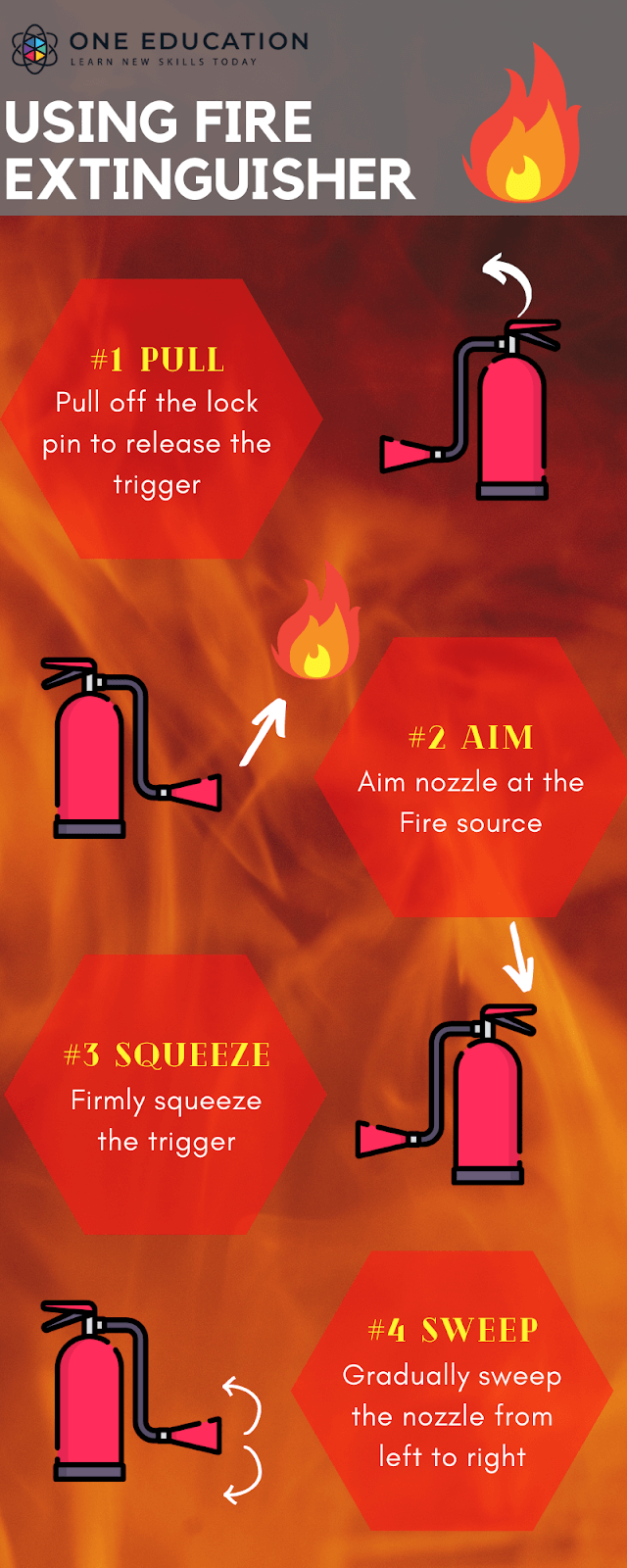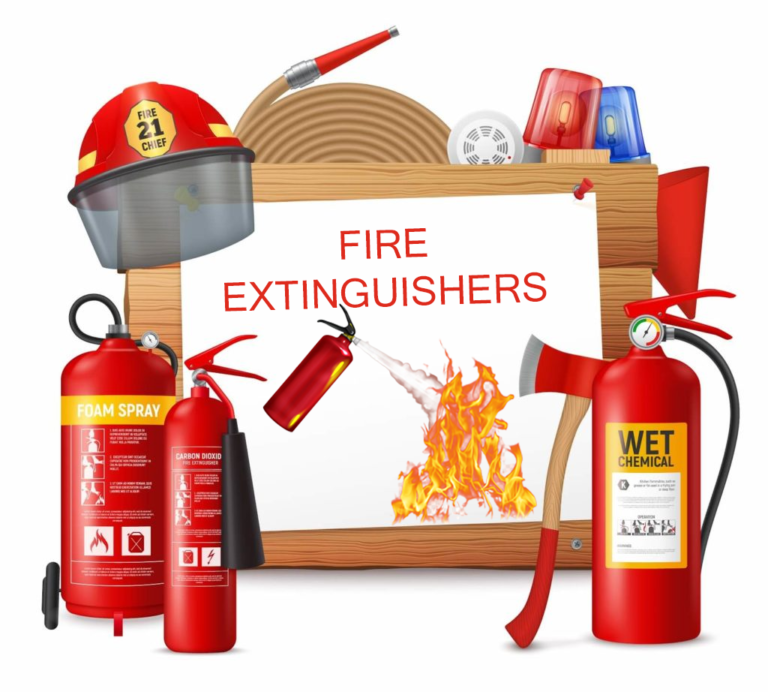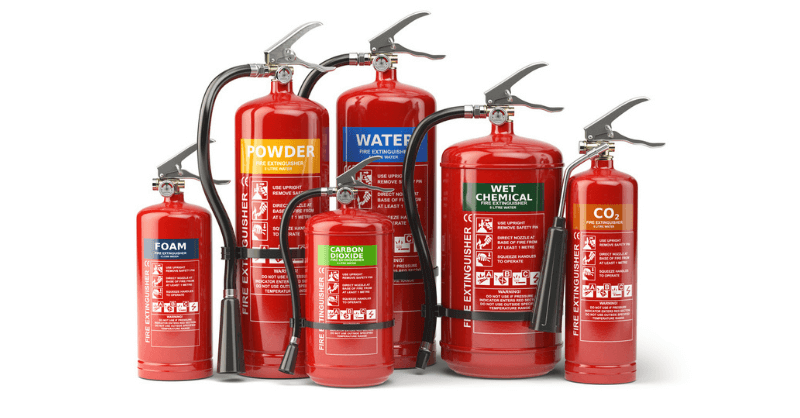Whether you walk into an office building or a school, one thing you will find is a fire extinguisher. Have you wondered though, if you are prepared to use one in an emergency? Well if not then rest assured. We’ve got you covered. On this blog, we’re going to cover the different types of Fire Extinguishers available on different premises. Along with it, we’re going to look at where and how to use them properly.
Table of Contents
Fire Safety Regulations
Before we get to extinguishers and related details, first let’s get familiar with the regulations associated with fire safety. In the UK fire safety regulations are enforced by the Fire Safety Law. Introduced in 2005, the law covers detailed regulations on managing fire related emergencies in urban and industrial workplaces.
Fire Safety Law
The regulations describe the following stakeholders as key responsible personnel regarding fire safety,
- Employers
- Property/Business Owners
- Contractors
- Tenants (in relation to maintenance, repair or safety of premises).
Duties
For these individuals, there are a number of key duties that need to be fulfilled with regards to fire safety,
- Assess fire safety risks.
- Enforce measures to reduce the risk of fire in the workplace.
- Put in place measures to protect people from fire-related harms.
If you are one of these responsible individuals, we recommend that you keep track of the measures in place to prevent fire emergencies and identify groups/individuals, particularly at risk.
UK Governments have strategised sector-specific guidance which can be found by visiting the CFOA ‘Government Guidance’ page.
Different Types of Fires
Fire emergencies have been systematically studied and there are extensive protocols to contain fires of different sorts. To properly use these protocols you need to know the fire triangle as well as the classification of fires. It is only appropriate that different types of fire extinguishers are used to manage each type of fire.
Class A Fires Fires caused by combustible materials such as paper, fabric, wood and other flammable solids are classified as Class A fires. Storage facilities and Office spaces are specially liable to these types of fires.
Class B Fires Fires caused by flammable liquids such as paint, turpentine or petrol among others are Class B fires. Gas stations and Industrial facilities are most prone to these types of fires.
Class C Fires Flammable gases including methane, butane or hydrogen etc. are the cause of Class C fire. These fires are especially concerning due to high dispersal conditions.
Class D Fires Fires caused by volatile metals including potassium, aluminium or magnesium among others.
Class F Fires Class F fires include those caused by cooking oils such as a chip-pan fire.
Class K Fires Fires related to Kitchen equipment are referred to as Class K fires. The classification includes both household and industrial kitchens.
Electrical Fires Fires involving electrical equipment are specifically termed Electrical fires. Upon removal of the electrical item, the fire class is changed.

Understanding the Fire triangle
The fire triangle or combustion triangle is a model for explaining and understanding the necessary ingredients involved in fires. The triangle contains the three elements a fire needs to ignite, which are heat, fuel, and an oxidizing agent (usually oxygen).
A fire naturally occurs when these 3 elements are present and combined in the correct mixture. Fires can be prevented or extinguished by removing any one of these elements.
For instance, covering a fire with a fire blanket blocks oxygen and can extinguish a fire. In large fires where firefighters are called in this is not a feasible solution. Mostly because decreasing the amount of oxygen is not possible in an extended area.
The fire tetrahedron represents the addition of a new component as a chemical chain reaction, to the existing three already present in the triangle. Once a fire is ignited, the resulting exothermic (heat releasing) chain reaction sustains it and allows it to continue until or unless at least one of the elements of the fire is exhausted.
Foam is used for the fact it can deny the fire the oxygen it needs. Water helps by lowering the temperature of the fuel below the ignition point or to displacing or disperse the fuel. Halon is used to remove free radicals and create a barrier of inert gas in a direct attack on the chemical reaction responsible for the fire, which effectively contains the fourth element of the tetrahedron.
8 different types of Fire Extinguishers

According to the UK fire regulation, all premises are bound to house some form of fire emergency management system. In most cases, this includes fire hoses, Fire hydrants and extinguishers. The goal of this section is to teach you the different types of extinguishers used in different settings. It also includes which extinguisher is appropriate for each fire type.
1. Water & Foam Extinguisher
The water and foam based extinguisher works by removing the two elements of the fire triangle. The water portion helps dissipate heat whereas the foam portion snuffs out the oxygen.
Works For: Class A fires only
These extinguishers function creating a cooling effect on the fuel. When poured on burning liquid, the fire is extinguished by creating a barrier between the fuel and the flame with the help of the foaming agent.
Foam extinguishers are especially important for businesses and premises where the building is made from organic materials or where such organic materials are stored, i.e. warehouses, residential properties, hospitals, schools, offices and buildings storing flammable liquids. In simple terms, most of the buildings require the presence of foam or water extinguishers.
[/su_note]2. Carbon Dioxide Extinguisher
Carbon dioxide (CO2) acts with dual action by both replacing the fire’s oxygen and creating a cold discharge upon release, which removes the heat of the fire too.
Works For: Class B and C fires
3. Dry Chemical Extinguisher
This type of extinguisher removes the chemical reaction of a fire. It is the most used of all fire extinguishers because of its versatility across multiple classes. This is the most common extinguisher found in corporate and business institutions as well as other urban premises. These are also the best type of fire extinguisher for home due to be multipurpose.
Works For: Class A, B and C fires (multi-purpose); Class B and C (ordinary)
4. Wet Chemical Extinguisher
This type of fire extinguisher removes heat and creates a barrier between oxygen and fuel so a fire cannot be re-ignited. The chemical is sprayed as a mist, cooling the fire’s heat and creating a blanket effect over the fuel. The separation causes the fire to lose strength and it eventually dies out.
Works For: Class K fires (particularly good for fires started by oils or fats)
5. Clean Agent Extinguisher
Also known as Halogenated extinguishers, these include halogen compounds. Newer editions contain less ozone depleting halocarbon agents. This type of extinguisher extinguishes a fire by interrupting the fundamental chemical reaction.
Works For: Class B and C fires
6. Dry Powder Extinguisher
Similar to the dry chemical extinguisher the powder extinguisher separates the fuel from oxygen or removes the heat. However, this extinguisher is only used to fight combustible metal fires as the volatile metals react more aggressively towards water-based solutions.
Works For: Class D fires
7. Water Mist Extinguisher
This extinguisher takes away the heat of the fire only. Which makes it less effective for chemical or fuel-based fires due to high burning temperatures. It is not to be used in the case of volatile metal-based fires.
Works For: Class A and C fires
8. Cartridge Operated Dry Chemical Extinguisher
This extinguisher interrupts the chemical reaction powering fire. It creates a barrier between the oxygen and the fuel similar to the dry chemical extinguishers. However, instead of using canisters, the extinguisher uses refillable cartridges so one nozzle can be used multiple times.
Works For: Class A, B and C fires
It’s important to use the right extinguisher for the type of fuel – using the incorrect one can allow a fire to re-ignite, even when it seems to have been put out successfully. We’ve put together a simple chart to help you choose the right extinguisher for your fire needs.
Related: The Ultimate Guide on Fire Safety Signs
Ending Notes
Keeping safe from fires is absolutely essential for every sort of workplace or premise where fire hazards are likely to be present. The safety regulations need to be followed carefully to avoid catastrophic accidents that may result in damages and the loss of life.
As an employer, you should pay extra attention to training your employees on fire safety. If you are an employee or contractor you need to be aware of these regulations to maintain the safety of your workplace and the well being of your coworkers in a fire emergency. Understanding the use and mechanisms of different types of extinguishers is particularly important to achieve this goal.
Recent posts
- How Long Should a Health Sector Career Take?
- The Importance of BSL in Everyday Life
- Why Corporate eLearning is Essential for Organisational Training
- Take your Business Expertise to the next level: Get your MBA
- Read to Lead: Books That Cultivate Effective Leadership Skills
- Crafting an Effective Home Schooling Curriculum: A Comprehensive Guide
- Learn How to Write a Term Paper | From Start to Finish
- Student Entrepreneurship: Creating and Selling Custom T-Shirts as a Learning Experience
- Easy Steps to Create Your Business Proposal. Contract proposal
- From Concept to Screen: Secrets to Captivating Educational Video Production







 January 09, 2021
January 09, 2021








